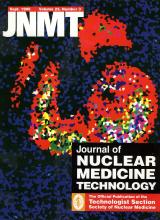Abstract
Objective: Optimized nuclear medicine imaging requires that collimator uniformity be as good as the corrected uniformity of the camera. In the past we have observed multiple artifacts with high-resolution foil but not with the high-resolution cast collimators. The purpose of our study was to determine if these collimator artifacts could be observed in other institutions using a variety of gamma cameras and collimators.
Methods: Ten medical centers in the Chicago area participated. Planar images of a 5-mCi (185-MBq) point source of 99mTc placed 5 m from the collimator face were obtained. Additional planar images of line sources placed at 0, 5, 10, 15, 20, 25 and 30 cm from the collimator face were also obtained. Tomographic images of a single SPECT phantom were acquired from five of the institutions under a defined protocol.
Results: With one exception, the 5-m point source images with low-energy high-resolution foil collimators (HRFC) demonstrated linear hot and cold streak artifacts, whereas low-energy high-resolution cast collimators (HRCC) did not. Linear defects were also present in the line source images at distances of 15 to 30 cm from the HRFC face but were absent or much less prominent with the HRCC. These foil-generated defects were not observed in one brand of HRFC, which may be related to the method of manufacturing. With the exception of this same manufacturer of HRFC, ring artifacts were noted in SPECT reconstructed images with HRFC-acquired data but not with HRCC-acquired data.
Conclusion: These findings illustrate the importance of properly evaluating the uniformity of each collimator purchased with any new camera system.







